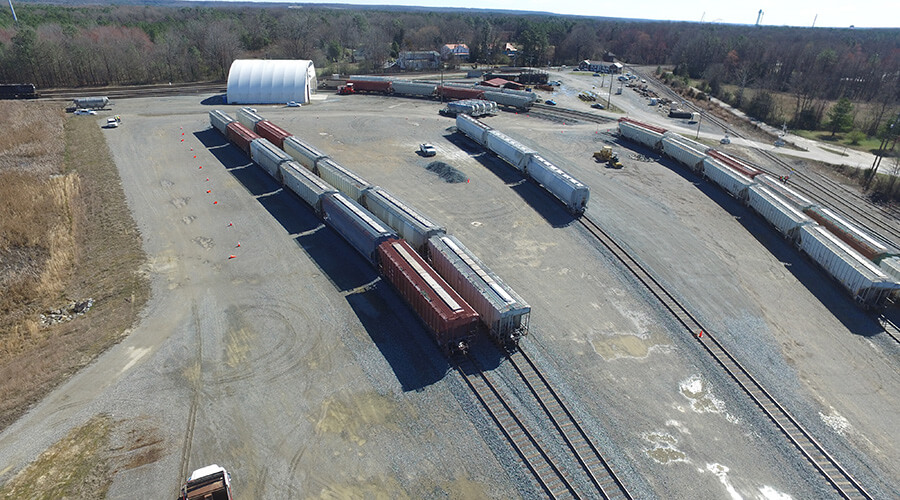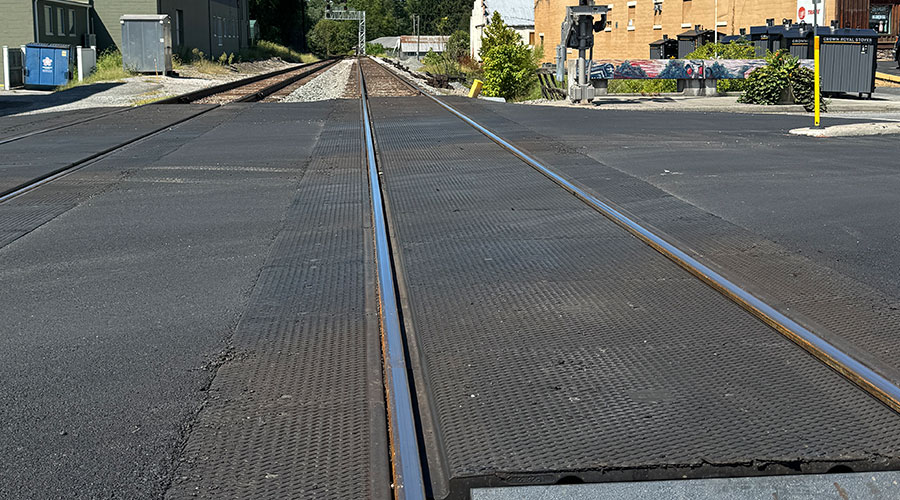Stay updated on news, articles and information for the rail industry
September 2006
Rail News: C&S
PTC: A positive development on the Panama Canal Railway
By Pat Foran, Editor
Panama's rail legacy is as colorful as the jungle foliage that flanks the republic's fabled canal. But there's more than pigment to the Panamanian rail story. In 1848, the Pacific Mail Steamship Co. was granted a charter to deliver mail between the United States and Panama; a year later, the U.S. company negotiated a 49-year concession with the Colombian government to build a railroad across the Republic of Panama. In 1855, the single-track Panama Railroad for the first time ran a train from the Atlantic Ocean across the Isthmus of Panama to the Pacific Ocean.
The railroad survived cataclysmic change — some of it cultural, all of it political — during the next 120 years. Between 1906 and 1909, construction of the 50-mile Panama Canal forced a significant segment of the railroad south of Gatun to be relocated — at $9 million, the move was $1 million more than it had cost to build the entire road 65 years earlier. Control of the railroad changed hands frequently — from Colombia to France to the United States and, under the terms of the Torrijos-Carter Treaties, to the Panamanian government in 1977.
That same year, Jay Wallace signed on as an engineer with the Panama Railroad, at that time strictly a freight hauler. He stayed 11 years before leaving in 1988 to go to work for the then newly formed Montana Rail Link — and, subsequently, several other North and South American railroads — before returning to the rechristened "Panama Canal Railway Co." (PCRC) as chief operating officer in 2001.
The railroad Wallace rejoined wasn't the one he'd left. In 1998, a joint venture between Kansas City Southern and Mi-Jack Products Inc. received a 50-year concession to rebuild and operate the line. Rebuild, the joint-venture owners did. Three years and $80 million later, they'd added a chapter to Panama's rail story by revitalizing the 47.6-mile PCRC with 280,000 tons of granite ballast, 150,000 concrete ties and 11,000 tons of 136-pound continuous-welded rail. And for the past five years, the PCRC has provided freight service between the Atlantic and Pacific oceans while doubling as an "executive commuter" and tourist passenger line.
"The thought of working with a railroad in Class I condition — that was the first thing that was really appetizing to me," Wallace says. "And for a railroader, with this railroad being as short as it is, I can sleep at home every night."
Chances are Wallace also has slept a little bit better of late. Since April, the PCRC has been blazing the positive train control (PTC) trail with a system Wallace believes helps him run a safer, more efficient railroad.
Developed by Quantum Engineering Inc., the Train Sentinel® Positive Train Control dispatching system is designed to prevent train-to-train collisions, enforce speed limits and temporary slow orders, and provide protection for roadway workers and equipment. An onboard computer, with location data provided by Global Positioning System (GPS) satellites, alerts crews to approaching restrictions and stops the train if the crew fails to respond appropriately.
"It's been a real confidence booster," Wallace says. "The advantage is that my authority is enforced rather than being 100 percent dependent on the locomotive engineer and his assistant. It's an ideal way for us to replace dark territory warrant control."
Positive Reinforcement
And Wallace, whose rail resumé includes tours of duty at roads in Argentina, Bolivia, Chile and Mexico, has seen his share of dark-territory collisions.
"When I came [back] to the Panama railroad, it was just going to be dark territory — track warrants or direct traffic control, which is what I'm used to," he says. "But there was a real need for a better control system. Sooner or later, an engineer will make a mistake."
Technology could play a role in helping to minimize the potential for human error, Wallace believed. Among the few train-control technology purveyors Wallace knew that could address the issue was Quantum, from which he'd ordered event recorders during his late 1990s-early 2000s stint with Bolivia's Empresa Ferroviaria Oriental.
"In the first months of 2001, [Quantum] had already been talking to some people in Brazil about Train Sentinel," Wallace says. "I said, ‘Panama looks like an ideal location to do some testing or implementation, as far as being a captive railroad and the equipment they had.' I thought it was something they might be interested in."
By that time, Quantum, which had done considerable collision-avoidance technology development work for several Class Is beginning in the early 1990s through 2004, also had an extensive train-control track record in South America.
"We had run across a couple of railroads that had a dispatching system to transmit electronic warrants from the dispatcher to the train — the crew had to respond with a concurrent message," says Quantum President Mark Kane. "There, the beginning of electronic train dispatch — not radio or voice communication — was satellite because they didn't have the infrastructure. But they were having a lot of accidents. While they could get the correct information to the crew, the crew wasn't always paying attention."
Quantum's solution? Train Sentinel, a system designed to force the train to conform to limits of authorities and speed restrictions via a GPS-based track map.
"We tested it on four or five railroads in South America, including in Brazil and Venezuela," Kane says.
Lack of funds precluded the railroads from implementing the technology systemwide, but for Quantum, the South American experience was invaluable.
"The technology evolved into a PTC system without any government regulation," Kane says. "It was a wonderful place to design and develop a train control system."
And the key to the Train Sentinel design is the interaction between the onboard
locomotive computer database, telemetry dispatching system and GPS. The database contains pertinent information about the territory's track, including sidings, turnouts, switches, interlockings and signals. The telemetry dispatching system issues or removes authorities for trains for any given track segment or route within the system; all track occupancies are verified by re-transmission to the dispatch computer. And the real-time GPS data overlay is accurate to within 10 yards.
Train crews interact with Train Sentinel through a display that presents real-time operating information, such as train speed, maximum authorized track speed, signal aspects, distance to signals, milepost locations and system-generated messages.
"The first response of Train Sentinel is always to notify the train crew, visually and audibly," Kane says. "But if they don't control the train in the required time or distance, Train Sentinel does it for them."
Equipped & Non-Equipped
While Quantum officials were refining Train Sentinel in South America, they also were talking about their technology with North American rail execs — including officials at PCRC joint owner KCS. Kane recalls a Saturday morning meeting in 2003 with KCS Chairman and Chief Executive Officer Mike Haverty: "Right off the cuff, he said, ‘Can you put [Train Sentinel] in Panama?'"
At about that same time, PCRC's Wallace, who needed to purchase some end-of-train devices, approached Quantum officials and asked, "How's it going with Train Sentinel?"
In 2004, Kane, Wallace and their respective crews began talking about what it would take to tailor the microprocessor-based Train Sentinel to the PCRC's needs — one of which was to have the option to continue operating in non-equipped mode.
"I wanted to be able to dispatch just as I am today — in dark territory," Wallace says. "I wanted Train Sentinel as an overlay."
To Kane, it made sense to adapt a version of the system Quantum had developed for a Brazilian railroad.
"In Brazil, they use no paper; if the electronic message doesn't get to the train, the train doesn't move," Kane says. "We had to redesign the Brazil system that was completely electronic and say, ‘What if we don't get radio telemetry communication between Sentinel and the dispatch computer?'"
That entailed sending the message in paper form so the engineer could read and repeat it to the crew.
"The idea is to have a system where you can use intermittent communication to control a train," Kane says.
During the system design phase, Quantum officials also opted to replace PCRC's dispatch system with the Engesis ACT computer-aided dispatching system.
"We can do it with any dispatching system, but we wanted to stay with what we knew," Kane says. "And we had been working with the Engesis system in Brazil since 1999."
The PTC team also elected to change communication system courses. The railway had been operating on six radio communication channels on the UHF band. But when a VHF channel became available, the team grabbed it. "VHF is stronger — it cuts through a lot of foliage, and they had several locations where they had black holes, in terms of communication," Kane says.
A Smooth Cutover
The PTC system implementation began in April 2005; by October, Train Sentinel and the existing dispatching system were running in parallel mode.
"We really didn't have any major challenges, except for modifying the dispatching system to the GCOR set of rules," says Kane,
referring to the General Code of Operating Rules, the rule book most North American railroads adopt.
Meanwhile, dispatcher and train crews were trained via a simulator adjacent to the PCRC's dispatcher's office.
"The beauty of the Panama Canal Railway is they've got engineers and assistant engineers who are fairly new," Kane says. "They took to the system like ducks to water."
Seasoned vets did, as well, Wallace adds, himself included.
"It's very simple to use," he says. "The only real problem I had during the simulation is the system was stopping more trains than I thought was necessary. The system doesn't have a mind of its own, that's for sure — it only does what you tell it. But whenever it seemed to err, it erred on the safe side."
(Note: The problems were "refined out of the system" by modifying the braking algorithm to account for the different style of cars and braking systems in use, Kane says.)
By February, the PCRC had been turned over completely to Train Sentinel control with one exception: "We still utilized voice response," Kane says. "We made 1,000 trips just to make sure the messaging was correct."
The official cutover occurred on April 26, 2006, making the PCRC "the first fully functional [PTC] system out there," says Kane.
Fully functional and, so far, issue free: Through early August, the PCRC had experienced "no problems at all" with PTC — "no operating issues, no accidents or anything," Wallace says.
Wallace declined to discuss the PTC project's costs other than to say he could "cost-justify it" — if nothing else because the PCRC ownership team supports the effort. "This is about doing a better job of preventing human error," Wallace says.
Of course, PTC's promise also includes the potential for a productivity boost.
"Through electronic means, the dispatcher becomes less a dispatcher than a manager of train operations," Kane says, adding that several U.S. railroads are "looking at" Train Sentinel, for which Quantum holds 18 patents. "That's the next step — thinking about how you make the next move. In high-capacity areas, we think this system will allow dispatchers to dispatch more trains per mile."
For now, rail capacity isn't an issue in Panama. Although intermodal container moves continue to increase — PCRC handled 101,000 last year and is on track to move 155,000 this year — the railroad can handle 300,000 annually without any additional equipment, Wallace says. And the PCRC's commuter/tourism passenger service comfortably complements the container moves.
But rail capacity is very much a concern in North America, where more dispatchers and train crews likely will be managing trains via PTC in the months ahead. In what the Federal Railroad
Administration characterized as an effort to "accelerate the implementation of train collision-prevention technology," the regulatory body last year issued new PTC system standards — the first revision of federal signal and train-control regulations in two decades.
The "Final Rule for Standards for Development and Use of Processor Based Signal and Train-Control Systems" establish minimum performance requirements, requiring PTC systems to meet or exceed conventional wayside signal systems' safety level. They also require railroads to deploy PTC systems that are compatible with one another, notify the FRA prior to installing PTC components, provide adequate employee training and improve record-keeping.
Meeting the rule's "mountains of paperwork and testing" requirements is an onerous challenge, says Kane, adding that Quantum was "60 to 70 percent of the way there" as of early last month.
"When we implement this technology on other railroads, we will have the submission ready," he adds.
Wallace, meanwhile, is looking forward to Train Sentinel meeting FRA's requirements, even though his railroad doesn't have to.
"Those are the standards I know, and those are the standards I want to live up to," he says.
In Panama, the legacy building continues.
Keywords
Browse articles on positive train control PTC Panama Canal RailwayContact Progressive Railroading editorial staff.


 LRW Honors Amtrak’s Acheson As Railway Woman Of The Year
LRW Honors Amtrak’s Acheson As Railway Woman Of The Year
 From Editor-In-Chief Foran: Of Gender Equity And Inclusion
From Editor-In-Chief Foran: Of Gender Equity And Inclusion
 Spotlight On Some Of Today’s Rail Safety Products
Spotlight On Some Of Today’s Rail Safety Products
 Women of Influence in Rail eBook
Women of Influence in Rail eBook
 railPrime
railPrime







